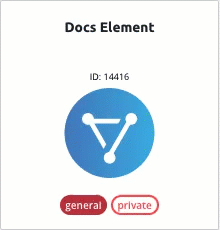SAP Hybris Cloud for Customer Helpdesk
Authenticate with SAP Hybris Cloud for Customer
You can authenticate with SAP Hybris Cloud for Customer to create your own instance of the SAP Hybris Cloud for Customer Helpdesk element through Cloud Elements or through APIs. You can use the authenticated element instance to access the different resources at the SAP Hybris Cloud for Customer Helpdesk platform.
Authenticate Through the UI
Use Cloud Elements to authenticate with SAP Hybris Cloud for Customer and create an element instance. If you are authenticating with events, see the Events section.
To authenticate an element instance:
- Sign in to Cloud Elements, and then search for SAP Hybris Cloud for Customer Helpdesk in our Elements Catalog.

- Hover over the element card, and then click Authenticate.

- Enter a name for the element instance.
- Complete the required parameters in the Configuration section: Subdomain, Username, and Password. See Parameters for descriptions.
- If you want to add events, go to Configure Polling Through the UI.
- Click Create Instance.
After successfully authenticating, we give you several options for next steps. Make requests using the API docs associated with the instance, map the instance to a virtual data resource, or use it in a formula template.
Authenticate Through API
Use the /instances endpoint to authenticate with SAP Hybris Cloud for Customer and create an authenticated element instance. If you are authenticating with events, see the Events section.
To authenticate an element instance:
Construct a JSON body as shown below (see Parameters):
{ "element": { "key": "sapc4chd" }, "configuration": { "subdomain": "<domain>.crm.ondemand.com", "username": "<YOUR_SAP_Hybris Cloud for Customer_USERNAME>", "password": "<YOUR_SAP_Hybris Cloud for Customer_PASSWORD>" }, "tags": [ "ElementDocs" ], "name": "<AUTHENTICATED_INSTANCE_NAME>" }Call the following, including the JSON body you constructed in the previous step:
POST /instancesNote: Make sure that you include the User and Organization keys in the header. See the Overview for details.Locate the
tokenandidin the response and save them for all future requests using the element instance.
Example cURL
curl -X POST \
https://staging.cloud-elements.com/elements/api-v2/instances \
-H 'Authorization: User <INSERT>, Organization <INSERT>' \
-H 'content-type: application/json' \
-d '{
"element": {
"key": "sapc4chd"
},
"configuration": {
"subdomain": "<domain>.crm.ondemand.com",
"username": "<YOUR_SAP_Hybris Cloud for Customer_USERNAME>",
"password": "<YOUR_SAP_Hybris Cloud for Customer_PASSWORD>"
},
"tags": [
"ElementDocs"
],
"name": "SAPC4HDCAPI1"
}
'
Parameters
API parameters not shown in Cloud Elements are in code formatting.
| Parameter | Description | Data Type |
|---|---|---|
| 'key' | The element key. sapc4chd |
string |
Namename |
The name for the element instance created during authentication. | string |
Subdomain subdomain |
The url of your SAP Hybris Cloud for Customer Helpdesk site. Replace |
|
| Username | Your user name for SAP Hybris Cloud for Customer Helpdesk. | String |
| Password | Your password for SAP Hybris Cloud for Customer Helpdesk. | String |
| tags | Optional. User-defined tags to further identify the instance. | string |
Example Response
{
"id": 50634,
"name": "SAPHybris Cloud for CustomerAPI1",
"createdDate": "2017-05-19T14:00:59Z",
"token": "4RFxtlivv2BW9oAoO64wCnLvwwps4SPCf6LyCUq8Ihg=",
"element": {
"id": 5353,
"name": "SAP Hybris Cloud for Customer Helpdesk",
"key": "sapc4chd",
"description": "Add a SAP Cloud for Customer (Hybris Cloud for Customer) Instance to connect your existing SAP Cloud for Customer (Hybris Cloud for Customer) account to the Helpdesk Hub, allowing you to manage accounts, contacts, leads, opportunities, etc. across multiple Helpdesk Elements. You will need your SAP Cloud for Customer (Hybris Cloud for Customer) account information to add an instance.",
"image": "elements/provider_sapc4c.png",
"active": true,
"deleted": false,
"typeOauth": false,
"trialAccount": false,
"resources": [],
"transformationsEnabled": true,
"bulkDownloadEnabled": true,
"bulkUploadEnabled": true,
"cloneable": true,
"extendable": false,
"beta": false,
"authentication": {
"type": "basic"
},
"extended": false,
"hub": "Helpdesk",
"protocolType": "odata",
"parameters": [
{
"id": 3990,
"createdDate": "2017-05-17T09:37:05Z",
"name": "subdomain",
"vendorName": "siteUrl",
"type": "configuration",
"vendorType": "path",
"source": "request",
"elementId": 5354,
"required": false
}
],
"private": false
},
"elementId": 5354,
"provisionInteractions": [],
"valid": true,
"disabled": false,
"maxCacheSize": 0,
"cacheTimeToLive": 0,
"configuration": { },
"eventsEnabled": false,
"traceLoggingEnabled": false,
"cachingEnabled": false,
"externalAuthentication": "none",
"user": { }
}